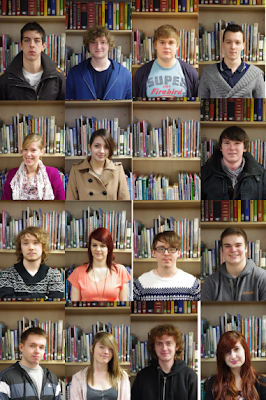Whilst Tom liked the plan including the actual yearbook, I kept pushing the first plan, because, not only was the grid of photos clearly going to be simpler, I believed it would be more effective; the faces staring directly out were going to catch people's eyes and draw their attention straight to our film. So, with this in mind, Tom and I used part of Tuesday's lesson to take volunteers into the library and photograph their head and shoulders against the quintessential school photo backdrop: a bookshelf. Pleased with the amount of photos we had taken, I went home, slipped the SD card into my laptop, and started editing away with photoshop.
I placed all of the photographs onto the canvas in order to get an idea of what the final poster was going to look like. That's when it dawned on me: THIS LOOKS REALLY AWFUL.
All of the volunteers couldn't have been more helpful, and I want to make clear that the abandoning of this idea is no fault of theirs. The problem is, it just doesn't look like a poster. Good posters jump out, grab your attention, and refuse to leave your mind until you walk into that cinema and purchase that ticket. What you see above is banal and bland; more effective as a sedative than a stimulant. Our quantitative audience research revealed that what audiences most looked for in a poster was an eye-catching image and images of the characters or actors. So, not only was this poster not performing its general role, it was not performing the specific roles required for it to appeal to our target audience.
Being entirely unhappy with this design (as you can probably tell), I went away thinking deeply about new possiblities and variations, keeping in mind the criteria set by our by our audience research results. I began to reconsider what it was that stood out to me most about our film. The predicament of the protagonist is definitely at the core of our film, but this is difficult to convey in a single poster, and besides, our target audience would be more interested in watching the film if they were yet to discover the nature of the protagonist's situation. Finally, it occurred to me: what gives the film its identity on first impression is the title - PENUMBRA (click here for an explanation).
So, last night, with the title of the film at the forefront of my mind, I began to construct an entirely new poster. I explained the idea over the phone to Tom, and from this he drew his own mock-ups of how the poster could look. The first two images below show the initial experiments carried out in photoshop yesterday evening, and the rest are all from different stage in the poster's production today. Below each image is an explanatory caption.
 |
| Inspired by this poster for Inception, I put the title at an angle spanning most of the poster, and gave it the signature glow of our title (important because A- it looks cool, and B- it relates to the definition of penumbra as a part of a shadow). Then, using internet tutorials, I learned how to mask layers in such a way that images can appear within text. Our lead-actors eyes can be seen peering out from the forth stroke of the M. |
 |
| Here, I was trying to see if it was possible to have an image show through more than one piece of text. Luckily, this process wasn't as difficult as I had expected. |
 |
| This morning, in Media, the first thing I did was to create lots of text layers which i then transfromed and arranged to make an interesting collage. |
 |
| I then grouped the text layers appropriately, then rasterized them and merged them so that different images (either from our film or relating to it) can be seen in different peices of text. |
 |
| Finally, here (at full resolution, provided you click on the image) is our new poster! In this final stage, I increased the vibrancy and brightness of the colours in the image of our protagonist from the back, so that he is more visible against the solid black background. I also added some text (in the same font as the title for conguity) to specify that the poster is advertising a short film, and some other text to credit Tom and I as directors. (For the crediting font, I searched online to find fonts similar to those used for crediting in actual film posters, and then downloaded and installed one called 'Rothman' from this website) |



yo blaine, I like the idea of a yearbook style poster, i think it may stand out better if you were to outline each photo in a vibrant colour,and space out the photos :)
ReplyDelete